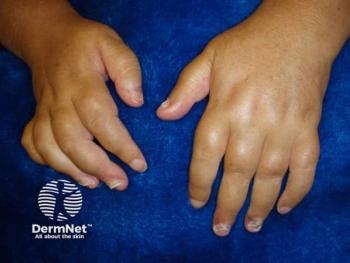
- Dermatology Times, October 2018 (Vol. 39, No. 10)
- Volume 39
- Issue 10
Synovial biopsies may hold psoriatic clues
In inflammatory arthritis, the molecular and genetic makeup of synovial tissues appears to hold clues that one day may guide clinical decision-making. Re: EULAR report.
In inflammatory arthritis, the molecular and genetic makeup of synovial tissues appears to hold clues that one day may guide clinical decision-making, says a physician in a presentation made at the European Congress of Rheumatology/European League Against Rheumatism (EULAR) meeting in June.
"We live in a paradoxical period in which rheumatologists use 21st-century therapies Рmonoclonal antibodies blocking very specific targets, including tumor necrosis factor (TNF), interleukin (IL)-6 in rheumatoid arthritis (RA) and IL-17 in psoriatic arthritis (PsA). Yet the categories we use to classify patients are 20th- or even 19th-century categories," said Bernard Lauwerys, M.D., Ph.D., of Universit̩ catholique de Louvain, Belgium.
Rheumatologists spend considerable time determining whether patients have rheumatoid, psoriatic or other types of arthritis, he explained. But these labels say nothing about disease severity and prognosis, or how to treat patients.
"It's time to move on. Many of us are looking at a new molecular taxonomy of rheumatic disorders. We believe that to design a molecular classification that makes sense, you should look in the joints rather than the blood, which is far away from where the disease occurs."
It is sometimes a diagnostic challenge even using all the tools we now have; namely, blood tests, x-rays, ultrasound, MRI and more. The tools we are developing probably will help us make the distinction," Dr. Lauwerys said.
To date, he said, treatment decisions for arthritis have rested largely on trial and error. "You start with a first-line drug. If that fails, you go to another first-line drug, and then second-line drugs according to the usual scheme. Can we do better? Can we personalize our therapeutic decisions? That's where looking at synovial tissue really can make a difference."
Histology has shown that in any arthritic joint, "You always see the same pattern of changes – hypervascularity, infiltration by inflammatory cells, diffuse aggregate and proliferation of fibroblasts." Yet different patient groups bear different histologic signatures. "With rheumatoid arthritis, you have more of everything; in psoriatic arthritis, you have more hypervascularity." When looking at individual patients' tissue samples, however, Dr. Lauwerys said it remains difficult to tell one condition from another.
"But when we started to do high-throughput transcriptomic studies, what was striking is that the molecular patterns in the tissues are very different. In rheumatoid arthritis, we had a lot of transcripts involved in T-cell and B-cell activation. In psoriatic arthritis, we had none of those. This tells us that although histology is very similar for whatever arthritis you see, molecular patterns are different."
In PsA, he said, investigations into the clinical utility of these markers are lacking. However, "In rheumatoid arthritis, we see that those variations in molecular patterns tell you something about the patient's status. In rheumatoid arthritis, those T-cell and B-cell activation genes correlate well with disease activity. We also found that variation in the expression of TNF-induced genes tells you something about disease severity." The more of these genes in a tissue sample, he explained, the less likely a patient is to respond to therapy.
"We are now trying to confirm these findings in multicentric prospective trials, to correlate the molecular patterns with clinically relevant information because this is what it's all about – can we base clinical decisions on those data?
Apparently, it is possible," according to a study published by Lauwerys et al. in Arthritis Research & Therapy in January 2016.
Crucial to the process, said Dr. Lauwerys, is the quality of clinical data used to supplement molecular and genetic data. "Everybody is running high-throughput genetic studies. But if you want that kind of experiment to succeed, you also need good quality clinical information. That's where I believe we make a difference – we combine those techniques with very good clinical characterization of patients." For example, correlating a specific molecular pattern with poor response to therapy requires using validated tools to document clinically that the patient is indeed a poor responder. "That is the job of the clinician," he said and it is an area where physicians can contribute, by tracking skin signs of psoriatic disease.
Ultimately, Dr. Lauwerys said, "I'm convinced that looking at the joints of patients with arthritis will tell us a lot about severity of the disease and the probability that a patient will respond to therapy. “
DISCLOSURES
Dr. Lauwerys owns a patent licensed to DNAlytics, which sells a kit to help rheumatologists diagnose undifferentiated arthritis based on molecular patterns.
REFERENCE
Bernard R Lauwerys MD. "Synovial Markers in Inflammatory Arthritis: Is This the New Holy Grail?" Annual European Congress of Rheumatology/European League Against Rheumatism (EULAR). June 15, 2018.
Articles in this issue
about 7 years ago
Skin differences in men and womenabout 7 years ago
Education at mammogram impacts skin cancer awarenessabout 7 years ago
Patients want genetic testingabout 7 years ago
The state of off-label drug lawsabout 7 years ago
Combined atopic dermatitis treatment shows promiseabout 7 years ago
Optimizing fillers for menabout 7 years ago
The value of online patient reviewsabout 7 years ago
AIVITA Biomedical names new CFO, VP of business developmentabout 7 years ago
Epiphany Dermatology partners with Sun City Dermatologyabout 7 years ago
The burden of electronic health record implementationNewsletter
Like what you’re reading? Subscribe to Dermatology Times for weekly updates on therapies, innovations, and real-world practice tips.

















